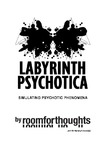LABYRINTH PSYCHOTICA - SIMULATING PSYCHOTIC PHENOMENA
| dc.contributor.supervisor | Phillips, Mike | |
| dc.contributor.author | Kanary Nikolov(a), Jennifer | |
| dc.contributor.other | Faculty of Arts, Humanities and Business | en_US |
| dc.date.accessioned | 2016-09-29T12:42:42Z | |
| dc.date.available | 2016-09-29T12:42:42Z | |
| dc.date.issued | 2016 | |
| dc.identifier | 10072227 | en_US |
| dc.identifier.uri | http://hdl.handle.net/10026.1/5509 | |
| dc.description.abstract |
This thesis forms a valuable tool of analysis, as well as an important reference guide to anyone interested in communicating, expressing, representing, simulating and or imagining what it is like to experience psychotic phenomena. Understanding what it is like to experience psychotic phenomena is difficult. Those who have experience with it find it hard to describe, and those who do not have that experience find it hard to envision. Yet, the ability to understand is crucial to the interaction with a person struggling with psychotic experiences, and for this help is needed. In recent years, the psychosis simulation projects Mindstorm, Paved with Fear, Virtual Hallucinations and Living With Schizophrenia have been developed as teaching and awareness tools for mental health workers, police, students and family members, so that they can better understand psychotic phenomena. These multimedia projects aim to improve understanding of what a person in psychosis is going through. This thesis represents a journey into taking a closer look at their designs and comparing them to biographical and professional literature. In doing so, throughout the chapters, a set of considerations and design challenges have been created that need to be taken into account when simulating psychosis. After a series of artistic case study labyrinths, Suicide Pigeon, Intruder, and Intruder 2.0, two final ‘do-it-yourself-psychosis’ projects have been created that have taken the aspects collected into account: The Labyrinth and The Wearable. Together these two projects form experiences that may be considered analogous to psychotic experiences. My original contribution to knowledge lies, on the one hand, within the function that both The Labyrinth and The Wearable have on a person’s ability to gain a better understanding of what it feels like to be in psychosis, and on the other hand within the background information provided on the context and urgency of psychosis simulation, how the existing simulations may be improved, and how labyrinthine installation art may contribute to these improvements. | en_US |
| dc.language.iso | en | en_US |
| dc.publisher | Plymouth University | en_US |
| dc.subject | Psychosis | en_US |
| dc.subject | VR | en_US |
| dc.subject | AR | en_US |
| dc.subject | Simulation | |
| dc.subject | Schizophrenia | |
| dc.subject | Mixed Reality | |
| dc.subject | Head Mounted Display | |
| dc.subject | Interactive | |
| dc.subject | Interactive | |
| dc.subject | Serious game | |
| dc.subject | Tool of Empathy | |
| dc.subject | Hallucinations | |
| dc.subject | Delusions | |
| dc.subject | Installation Art | |
| dc.subject | Labyrinth | |
| dc.subject | Wearable | |
| dc.subject | Labyrinth Psychotica | |
| dc.subject | Jennifer Kanary | |
| dc.subject.classification | PhD | en_US |
| dc.title | LABYRINTH PSYCHOTICA - SIMULATING PSYCHOTIC PHENOMENA | en_US |
| dc.type | Thesis | |
| plymouth.version | publishable | en_US |
| dc.identifier.doi | http://dx.doi.org/10.24382/3716 | |
| dc.rights.embargoperiod | No embargo | en_US |
| rioxxterms.funder | Not available | en_US |
| rioxxterms.identifier.project | Not available | en_US |
Files in this item
This item appears in the following Collection(s)
-
01 Research Theses Main Collection
Research Theses Main





